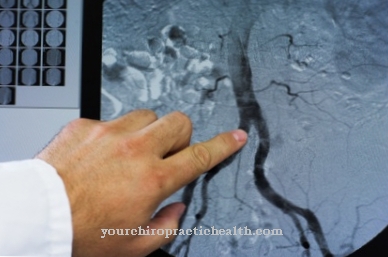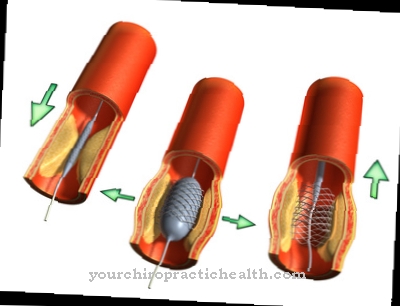As percussion is the name given to tapping the body surface for diagnostic purposes. The percussion is part of the physical examination and allows conclusions to be drawn about the density, size and consistency of the tissues and organs that lie under the knocking point through different sound reflections.
What is the percussion?

The term percussion comes from Latin. There "percussio" means hitting or knocking. When percussing, a distinction is made between direct and indirect percussion.
With direct percussion, the fingers are percussed directly on the skin. This process was first described by Joseph Leopold von Auenbrugger in 1761. Originally, four fingers on one hand were used for this. Today, however, the edge of the hand is also used for direct percussion (e.g. for percussion of the kidney bearings) or the hand clenched into a fist, for example for percussion of the spine.
In the later developed method of indirect percussion, a finger of one hand is first pressed onto the area of the body that is to be examined. Then one finger of the other hand is tapped on this finger, which is also known as the plessimeter finger. Instead of the plessimeter finger, a plessimeter can also be used. This is a thin plastic or surgical steel spatula. The knocking sound produced with the help of a plessimeter is louder than the knocking sound that is produced during percussion with a plessimeter finger. In both cases, however, the percussion is done loosely from the wrist, with a quick and springy beat.
Different sound qualities are distinguished in percussion. A loud, persistent and hollow tone is called sonorous. A hypersonic knocking sound is louder, longer lasting and more hollow than the sonorous knocking sound and can be interpreted as an indication of an excessive air content. A muffled knock sounds rather soft and dull. It is also known as thigh sound, because the sound is comparable to the sound that is heard when you tap the thigh. A tympanic knocking sounds hollow, full-pitched and like a drum. It indicates cavities or distended intestinal loops.
Function, effect & goals
Percussion can be used to examine all organ systems. Percussing the abdominal cavity is primarily aimed at determining air accumulations or congestion in the intestinal area. If the patient suffers from severe abdominal pain, percussion is first performed away from the pain, otherwise the abdominal cavity is divided into four quadrants and one quadrant after the other is percussed.
Normally, the tapping sound in the abdominal area above the organs is hyposonic. It can also be hypersonic to tympanitic over empty sections of the intestine. In the case of very large accumulations of air, there is a strong tympany. If thigh sound can be heard through hollow organs such as the intestine, this can indicate a large tumor or a stool accumulation due to constipation. Percussion can also be used to determine the size of the liver. Percussion of the lungs can be particularly instructive. Since the lungs are usually always filled with some air, the knocking sound that is generated sounds loud and low-frequency.
It is a sonorous knocking sound. If the knocking sound above the lungs is hyposonic, i.e. more muffled than the sonorous knocking sound, a lung tumor or an infectious infiltration of the lungs is suspected. In the case of hypersonic sound, air accumulations or air pockets in the lungs or in the chest cavity can be the cause. These can be caused, for example, by a pneumothorax, i.e. an accumulation of air in the gap between the lungs and the lung membrane.
Pneumothorax makes breathing difficult and can be life-threatening. If there is damping over the lung tissue, the ability to vibrate is reduced.
This can be due to extensive tissue compression or fluid accumulation in the lungs or in the gap between the lungs and pleura. Tissue compaction can be caused by tumors. Fibroses, i.e. diseases that result in a connective tissue remodeling of the lung tissue, must also be taken into account in the case of a hyposonic knocking sound. The same applies to pulmonary edema. This is where the water stored in the alveoli causes the damping. Percussion can also be used to test the mobility of the diaphragm and thus the flexibility of the lung borders. This would be limited in the case of an inflated lung, pulmonary fibrosis or neurological deficits.
But not only the sound quality provides information about the patient's state of health during percussion. If tapping the corresponding areas causes pain, it can be assumed that the organs tapped are pathological. Knock-painful kidney beds, for example, indicate inflammation of the renal pelvis, knock-painful bones can be the result of osteoporosis or a tumor disease of the bones.
You can find your medication here
➔ Medication for shortness of breath and lung problemsRisks, side effects & dangers
Percussion is a low-risk and side-effect-free examination method and is therefore an integral part of physical examinations. Basically there is only one possible complication with percussion and it is extremely rare. In the case of highly porous bones, for example caused by advanced osteoporosis or a massive bone tumor, the percutaneous bones can break.
However, it should be noted that the vibrations generated by the percussion can only penetrate about five to seven centimeters into the depth. This means that underlying pathological changes cannot be determined by means of percussion. A negative finding with the percussion does not rule out a disease of the corresponding organ. In obese patients, it is more difficult to obtain percussion findings. Depending on the body size, the vibrations may not even reach the organs, so that an almost generalized thigh sound could be heard.













.jpg)

.jpg)
.jpg)











.jpg)